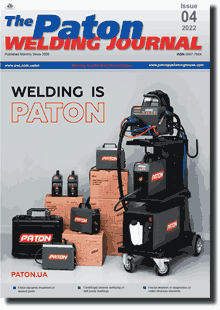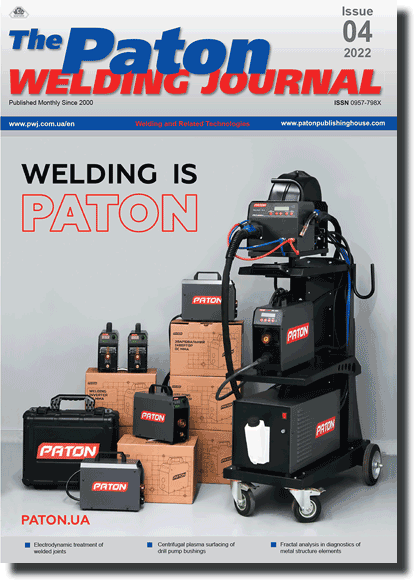| 2022 №04 (01) |
DOI of Article 10.37434/tpwj2022.04.02 |
2022 №04 (03) |

The Paton Welding Journal, 2022, #4, 8-13 pages
Features of the structure and properties of metal layers deposited with pre-application of titanium and boron carbides
V.V. Peremitko, I.V. Kolomoyets, V.I. Sukhomlyn
Dnipro State Technical University 2 Dniprobudivska Str., 51900, Kamianske, 2, Ukraine. E-mail: vperemitko1965@gmail.com
Abstract
Uneven wearing of working surfaces of parts, operating under friction, is a common cause for beginning of renovation and replacement times. One of the methods to avoid this problem is formation of surfaces of a variable composition and properties by arc surfacing. The work presents comparative analysis of the hardness and structure of the metal, deposited with pre-application of titanium and boron carbides on the processed surfaces. These materials were selected, proceeding from their impact on the deposited metal mechanical properties. The hardness, structure and composition of the deposited metal were studied. Hardness dependence on the heat input and material consumption in individual zones of the bead cross-section was analyzed. Regularities were established between accumulation in the formed beads of material pre-applied on the processed surface and the significance of structural transformations. A similar influence of both the carbides on the deposited metal structure was found. Bead metal hardness is 1.5 times higher at B4C application, than when TiC is used. X-Ray spectral microanalysis revealed the influence of free carbon, formed as a result of compound decomposition, on structural transformation in the deposited metal. It was found that the largest accumulations of bainite are characteristic for zones with the highest carbon content. It was determined that pre-application of carbides, using the most common surfacing materials, allows producing deposited metal, matching by its properties the metal deposited with PP-Np-152 wire.
Keywords: arc surfacing, solid wire, fused flux, titanium carbide, boron carbide, pre-application, local fixation, hardness, structure
Received: 19.04.2022
Accepted: 30.06.2022
References
1. Leschinskiy, L.К., Gulakov, S.V., Stepnov, K.K., Nosovskiy, B.I. (1985) Valki s naplavlennym sloyem novoy koncstruktsiyi povishayut effectifnost` raboty prokatnykh stanov [Newly designed hardfaced rolls improve rolling mill efficiency], in Gladkiy, P.V. (ed), Kyiv, Ukraine [in Russian].2. Ivanov, V.P. (2019) Theoretical and technological bases of increasing the efficiency of electric arc surfacing on the basis of modeling of formation of welding bath. D. Sc. Thesis, Pryazovskyy Derzhavnyy Tekhnichnyy Universytet, Mariupol, Ukraine [in Russian].
3. Yaryza-Stetsenko A.V. (2012) Increasing of arc hardfacing technology with variable chemical composition by alloying of it from flux. Abstract of PhD. Donbass`ka Mashynobudivna Akademiya, Kramatorsk, Ukraine [in Russian].
4. Kragelskiy, I.V. Treniye i iznos [Friction and wear] (1968) Moscow, Mashinostroyeniye [in Russian].
5. Chigarev V.V., Ivanov V.P., Psaryova I.S. (2003) Increasing of details' and parts' performance by hardfacing of heterogeneous layer. Zakhyst metalurgiynykh mashyn vid polomok, 7, 234-237 [in Russian]. https://doi.org/10.1134/1.1649416
6. Schenfeld, V.Y. (2014) Increasing of wear resistance of steel parts by surfacing with the use of carbon fiber materials. PhD Thesis, Vinnytskyy Derzhavnyy Tekhnichnyy Universytet, Vinnytsya, Ukraine [in Russian].
7. Peremitko, V.V. (2014) Wear resistant arc hardfacing by layer of alloying blend. Paton Welding Journal, 8, 56-59. https://doi.org/10.15407/tpwj2014.08.09
8. Peremitko, V.V., Panfilov, A.I. (2017) Arc hardfacing of metal layers with variable composition and properties. Ibid, 7, 48-52. https://doi.org/10.15407/as2017.07.08
9. Kuznetsov, V.V., Stepanov, D.V. (2015) Structure and properties of welded joint`s metal modificated by nanooxides. Ibid, 6-7, 19-24.
10. Kuznetsov, V.V., Stepanov, D.V. (2015) Wear resistant hardfacing with adding to welding bath of nanopowders. Ibid, 5-6, 54-56. https://doi.org/10.15407/tpwj2015.06.11
11. Babinets A.A., Ryabtsev I.O. (2021) Influence of modification and microalloying on deposited metal structure and properties (Review). Ibid, 10, 3-10. https://doi.org/10.37434/tpwj2021.10.01
12. Ryabtsev, I.A., Panfilov, A.I., Babinets, A.A. et al. (2015) Structure and wear resistance during abrasive wear of welded metal, hardened by carbides of different types. Ibid, 5-6, 84-88. https://doi.org/10.15407/tpwj2015.06.17
13. Zhudra, A.P. (2014) Investigation of wear resistance of composite layers during gas abrasive wear during increased temperatures. Ibid, 11, 31-34. https://doi.org/10.15407/tpwj2014.11.05
14. Peremitko, V.V., Kolomoyets, I.V., Sukhomlin, V.I. (2019) Influence of preliminary application of alloying powders on structure and hardness of welded metal. Ibid, 9, 40-44. https://doi.org/10.15407/tpwj2019.09.05
15. Peremitko, V.V., Kolomoyets, I.V. (2021) Influence of orientation of zones of higher hardness of composite layers on their resistance to wear. Archives of Materials Science and Engineering, 110, 59-71. https://doi.org/10.5604/01.3001.0015.4313
Suggested Citation
V.V. Peremitko, I.V. Kolomoyets, V.I. Sukhomlyn (2022) Features of the structure and properties of metal layers deposited with pre-application of titanium and boron carbides. The Paton Welding J., 04, 8-13.The cost of subscription/purchase order journals or individual articles
| Journal/Currency | Annual Set | 1 issue printed |
1 issue |
one article |
| TPWJ/USD | 384 $ | 32 $ | 26 $ | 13 $ |
| TPWJ/EUR | 348 € | 29 € | 24 € | 12 € |
| TPWJ/UAH | 7200 UAH | 600 UAH | 600 UAH | 280 UAH |
| AS/UAH | 1800 UAH | 300 UAH | 300 UAH | 150 UAH |
| AS/USD | 192 $ | 32 $ | 26 $ | 13 $ |
| AS/EUR | 180 € | 30 € | 25 € | 12 € |
| SEM/UAH | 1200 UAH | 300 UAH | 300 UAH | 150 UAH |
| SEM/USD | 128 $ | 32 $ | 26 $ | 13 $ |
| SEM/EUR | 120 € | 30 € | 25 € | 12 € |
| TDNK/UAH | 1200 UAH | 300 UAH | 300 UAH | 150 UAH |
| TDNK/USD | 128 $ | 32 $ | 26 $ | 13 $ |
| TDNK/EUR | 120 € | 30 € | 25 € | 15 € |
AS = «Automatic Welding» - 6 issues per year;
TPWJ = «PATON WELDING JOURNAL» - 12 issues per year;
SEM = «Electrometallurgy Today» - 4 issues per year;
TDNK = «Technical Diagnostics and Non-Destructive Testing» - 4 issues per year.


